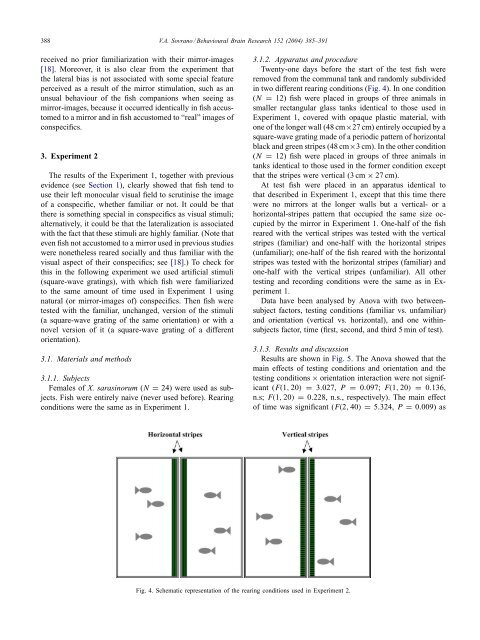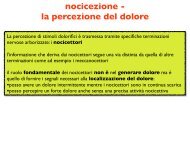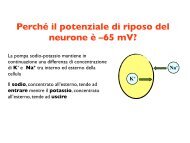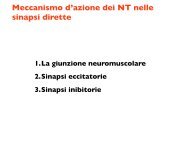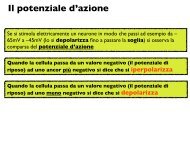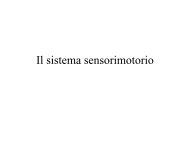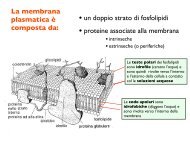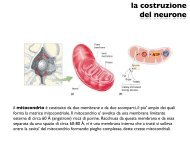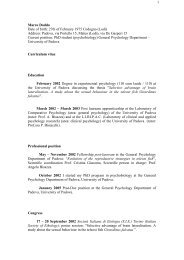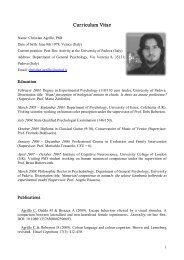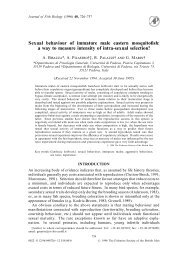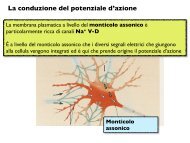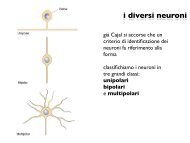Visual lateralization in response to familiar and unfamiliar ... - CPRG
Visual lateralization in response to familiar and unfamiliar ... - CPRG
Visual lateralization in response to familiar and unfamiliar ... - CPRG
You also want an ePaper? Increase the reach of your titles
YUMPU automatically turns print PDFs into web optimized ePapers that Google loves.
388 V.A. Sovrano / Behavioural Bra<strong>in</strong> Research 152 (2004) 385–391<br />
received no prior <strong>familiar</strong>ization with their mirror-images<br />
[18]. Moreover, it is also clear from the experiment that<br />
the lateral bias is not associated with some special feature<br />
perceived as a result of the mirror stimulation, such as an<br />
unsual behaviour of the fish companions when see<strong>in</strong>g as<br />
mirror-images, because it occurred identically <strong>in</strong> fish accus<strong>to</strong>med<br />
<strong>to</strong> a mirror <strong>and</strong> <strong>in</strong> fish accus<strong>to</strong>med <strong>to</strong> “real” images of<br />
conspecifics.<br />
3. Experiment 2<br />
The results of the Experiment 1, <strong>to</strong>gether with previous<br />
evidence (see Section 1), clearly showed that fish tend <strong>to</strong><br />
use their left monocular visual field <strong>to</strong> scrut<strong>in</strong>ise the image<br />
of a conspecific, whether <strong>familiar</strong> or not. It could be that<br />
there is someth<strong>in</strong>g special <strong>in</strong> conspecifics as visual stimuli;<br />
alternatively, it could be that the <strong>lateralization</strong> is associated<br />
with the fact that these stimuli are highly <strong>familiar</strong>. (Note that<br />
even fish not accus<strong>to</strong>med <strong>to</strong> a mirror used <strong>in</strong> previous studies<br />
were nonetheless reared socially <strong>and</strong> thus <strong>familiar</strong> with the<br />
visual aspect of their conspecifics; see [18].) To check for<br />
this <strong>in</strong> the follow<strong>in</strong>g experiment we used artificial stimuli<br />
(square-wave grat<strong>in</strong>gs), with which fish were <strong>familiar</strong>ized<br />
<strong>to</strong> the same amount of time used <strong>in</strong> Experiment 1 us<strong>in</strong>g<br />
natural (or mirror-images of) conspecifics. Then fish were<br />
tested with the <strong>familiar</strong>, unchanged, version of the stimuli<br />
(a square-wave grat<strong>in</strong>g of the same orientation) or with a<br />
novel version of it (a square-wave grat<strong>in</strong>g of a different<br />
orientation).<br />
3.1. Materials <strong>and</strong> methods<br />
3.1.1. Subjects<br />
Females of X. saras<strong>in</strong>orum (N = 24) were used as subjects.<br />
Fish were entirely naive (never used before). Rear<strong>in</strong>g<br />
conditions were the same as <strong>in</strong> Experiment 1.<br />
3.1.2. Apparatus <strong>and</strong> procedure<br />
Twenty-one days before the start of the test fish were<br />
removed from the communal tank <strong>and</strong> r<strong>and</strong>omly subdivided<br />
<strong>in</strong> two different rear<strong>in</strong>g conditions (Fig. 4). In one condition<br />
(N = 12) fish were placed <strong>in</strong> groups of three animals <strong>in</strong><br />
smaller rectangular glass tanks identical <strong>to</strong> those used <strong>in</strong><br />
Experiment 1, covered with opaque plastic material, with<br />
one of the longer wall (48 cm×27 cm) entirely occupied by a<br />
square-wave grat<strong>in</strong>g made of a periodic pattern of horizontal<br />
black <strong>and</strong> green stripes (48 cm×3 cm). In the other condition<br />
(N = 12) fish were placed <strong>in</strong> groups of three animals <strong>in</strong><br />
tanks identical <strong>to</strong> those used <strong>in</strong> the former condition except<br />
that the stripes were vertical (3 cm × 27 cm).<br />
At test fish were placed <strong>in</strong> an apparatus identical <strong>to</strong><br />
that described <strong>in</strong> Experiment 1, except that this time there<br />
were no mirrors at the longer walls but a vertical- or a<br />
horizontal-stripes pattern that occupied the same size occupied<br />
by the mirror <strong>in</strong> Experiment 1. One-half of the fish<br />
reared with the vertical stripes was tested with the vertical<br />
stripes (<strong>familiar</strong>) <strong>and</strong> one-half with the horizontal stripes<br />
(un<strong>familiar</strong>); one-half of the fish reared with the horizontal<br />
stripes was tested with the horizontal stripes (<strong>familiar</strong>) <strong>and</strong><br />
one-half with the vertical stripes (un<strong>familiar</strong>). All other<br />
test<strong>in</strong>g <strong>and</strong> record<strong>in</strong>g conditions were the same as <strong>in</strong> Experiment<br />
1.<br />
Data have been analysed by Anova with two betweensubject<br />
fac<strong>to</strong>rs, test<strong>in</strong>g conditions (<strong>familiar</strong> vs. un<strong>familiar</strong>)<br />
<strong>and</strong> orientation (vertical vs. horizontal), <strong>and</strong> one with<strong>in</strong>subjects<br />
fac<strong>to</strong>r, time (first, second, <strong>and</strong> third 5 m<strong>in</strong> of test).<br />
3.1.3. Results <strong>and</strong> discussion<br />
Results are shown <strong>in</strong> Fig. 5. The Anova showed that the<br />
ma<strong>in</strong> effects of test<strong>in</strong>g conditions <strong>and</strong> orientation <strong>and</strong> the<br />
test<strong>in</strong>g conditions × orientation <strong>in</strong>teraction were not significant<br />
(F(1, 20) = 3.027, P = 0.097; F(1, 20) = 0.136,<br />
n.s; F(1, 20) = 0.228, n.s., respectively). The ma<strong>in</strong> effect<br />
of time was significant (F(2, 40) = 5.324, P = 0.009) as<br />
Fig. 4. Schematic representation of the rear<strong>in</strong>g conditions used <strong>in</strong> Experiment 2.


